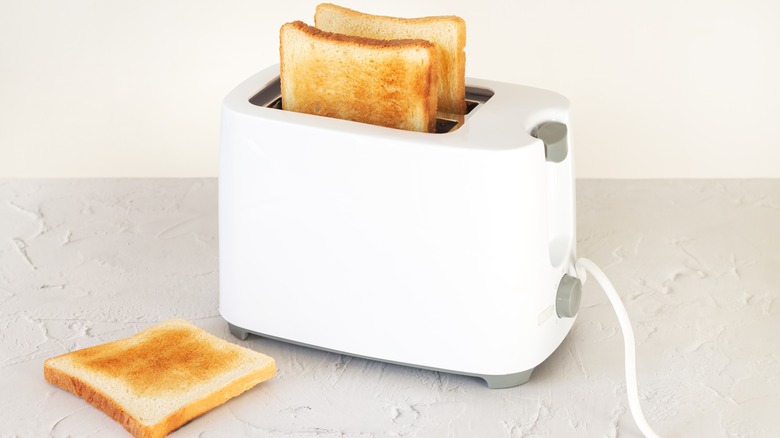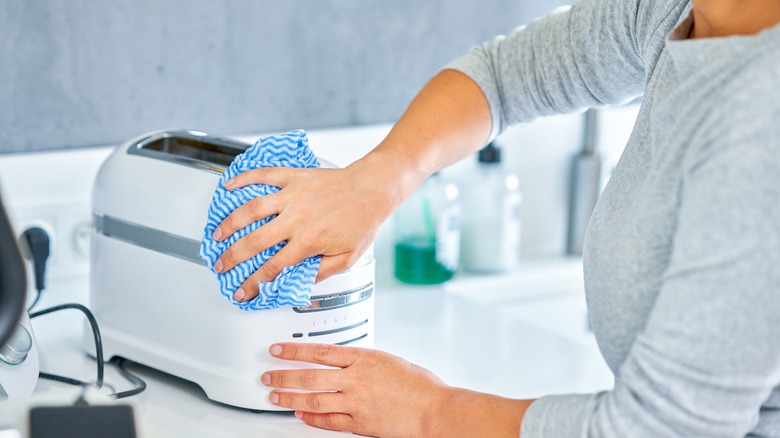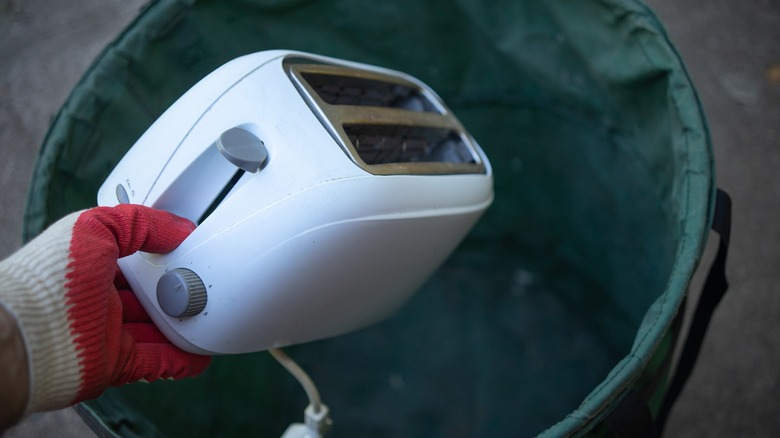The Easiest Approach To Getting Crumbs Out Of Your Toaster
A simple piece of toast is one of the small joys in life. Whether you just want a small, quick, and easy breakfast, something light to help settle an upset stomach, or the perfectly crispy, crunchy edge to a hearty sandwich, toasted bread is an everyday delight. But while we might take toast for granted these days, it wasn't until fairly recently that people had the luxury of toasting their bread from the comfort of their own kitchens.
In 1905, an engineer named Albert Marsh came up with the design for the very first electric toaster, according to John Desmond. Prior to that, toast could only be made using fire, which was much more time-consuming, not to mention dangerous. The electric model was patented by the American Electrical Heater Company in 1906 but didn't really catch on until General Electric began selling its first electric D-12 model in 1909, per Hagley. These early models used a single heating element that could only toast one side of the bread at a time, so people had to worry about their toast burning if they forgot to manually flip it over to the other side in time. However, this worry over burnt toast is now largely a thing of the past, thanks to the invention of the pop-up toaster, which was first released in 1921.
Crumbs can be a fire hazard
With modern toasters, one simply has to set the timer to their preferred toast level and wait for the perfectly crisp, browned bread to pop right out of the toaster on its own. In fact, these days, the main thing people have to worry about when it comes to their toasters is how to get rid of all those lingering crumbs that fall into the bottom of the device. If you've ever accidentally dislodged your toaster oven, you might have been surprised at the number of bread crumbs that came pouring out of it. No matter how careful you are, crumbs ending up in your toaster are pretty much inevitable, but that doesn't mean they have to stay there. In fact, leaving them in there could even be downright dangerous. Vera Peterson, president of Molly Maid, recommends "removing crumbs and any food residue that could cause a burnt taste or a fire on a weekly basis," according to Martha Stewart. But what is the best way to get rid of those pesky crumbs?
Before you begin any cleaning, it's important to remember to unplug the toaster from the electric outlet. Now, with the risk of accidental electrocution pretty much eliminated, it's time to get to work. Peterson advises first removing the crumb tray, which is a small compartment located underneath the control panel on most models that are designed to help catch crumbs, and dumping its contents straight into the garbage.
Signs it's time to replace your toaster
In addition to crumbs, some old food materials may have gotten stuck onto the bottom of the crumb tray. These can be removed using a combination of dish detergent and warm water, and a sponge or even an old toothbrush can be used to buff away the most stubborn gunk. Once the crumb tray is cleaned, you can eliminate the remaining crumb pieces by simply turning the entire toaster upside down over the sink or garbage can, giving it a gentle shake, and letting gravity do the rest. Any large or stubborn pieces that refuse to fall out can be carefully removed using tweezers, per Martha Stewart, but once you have turned it right side up, the bulk of the crumbs should be gone.
However, no matter how well you clean and maintain your toaster, at some point, it will eventually run out of steam and have to be replaced. Old toasters can even be a fire hazard. So if you begin to notice rust forming on the machine, or that the cord has begun to fray, then it is probably time to retire your appliance, according to CNET. On average, toasters should be replaced every six to eight years in order to reduce the risk of fire and ensure they keep operating at their best, per Mister Sparky.


